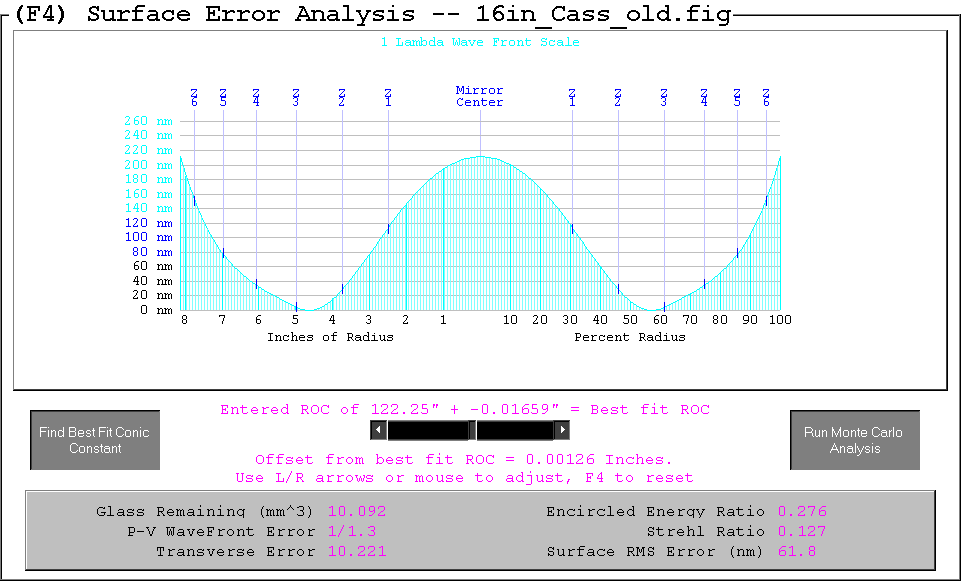Primary Mirror Testing - Initial Results
Coating
removal, glass condition:
The coating removal was quick and painless. Using Ferric
Chloride, the coating came off in about 20 minutes, much more quickly
than I am accustomed
to (1 hour+), confirming that it was quite seriously degraded.
After rinsing and cleaning the mirror, the optical surface appeared to
be in good condition, with a good polish and no observed
scratches. I did not note any areas that were no longer polished,
only some large pits created where bubbles in the glass have been
opened up on the optical surface. (Given the number of bubbles in
the disk, this was nearly impossible to avoid.) There are 3-5
such open bubbles, from 1/8" diameter to 1/32", and they will have no
effect on the images if blacked out.
The coating removal did not remove about four small drops of what
appeared to be black paint, which I had to scrape off the optical
surface with a razor blade. This was done without incident.
(A polished optical surface is quite robust, and such scraping, with
proper care, will not scratch it.) I also scraped some paint off
the edge of the disk to aid in later cleaning and coating.
Other than this, the mirror has one chip near the top of the side under
the optical surface. Fracture marks are apparent under the
surface, but no damage makes its way to the surface, and no defect is
visible under the Foucault test. The chip has been ground so that
there are no sharp edges, so the mishap that created it and the
fracture marks likely happenned when the mirror was being made.
The optical
surface is not exactly round, or the central hole is not exactly
centered in the primary, which makes testing a little more
challenging. Fortunately, I am getting consistent test readings.
Initial Figure
Test Results:
Now for the information we've all been waiting to hear.
The primary has a focal length of 61.125", and focal
ratio of F/3.77. This is consistent with Bill Cochran's
measurements, but not the original specs.
The surface of the
mirror is reasonably smooth, with no visible ripple, and the edge is
good (i.e., not significantly turned).
With two
consistent sets of Foucault test data recorded, I can say with
confidence that the mirror has a best fit conic constant is
approximately -0.9, indicating the mirror is ellipsoidal in figure.
IF an ellpisoid had been the intended figure (such as for a
Dall-Kirkham
design), then the mirror has at best a peak-to-valley wavefront error
of 1/5 wave, and a Strehl ratio of 0.9. I would rate this mirror
as good, but not excellent.
We have determined of late that a parabola was indeed the intended
figure (for
a classical cassegrain
design). Therefore, the mirror has a peak-to-valley wavefront
error of 2/3
wave. This would be classified by me as quite a poor figure, and
it
would seriously and obviously degrade the performance of the
system as it is significantly undercorrected.
Refiguring
will require a bit of time and effort, but it is quite
manageable.
I've seen (and fixed) much worse!! Here's a screen shot of the
surface error, with wavefront error ratings listed below the
plot. The value of 260 nm at the top of the plot corresponds to a
surface error of 1/2 wave, and a wavefront error of 1 wave. (I
personally work until the surface error is smooth and below 30 nm.)


